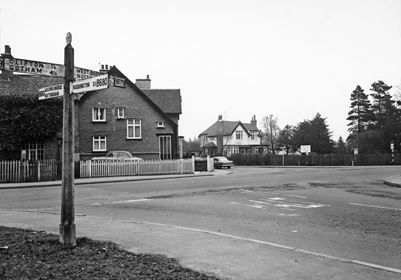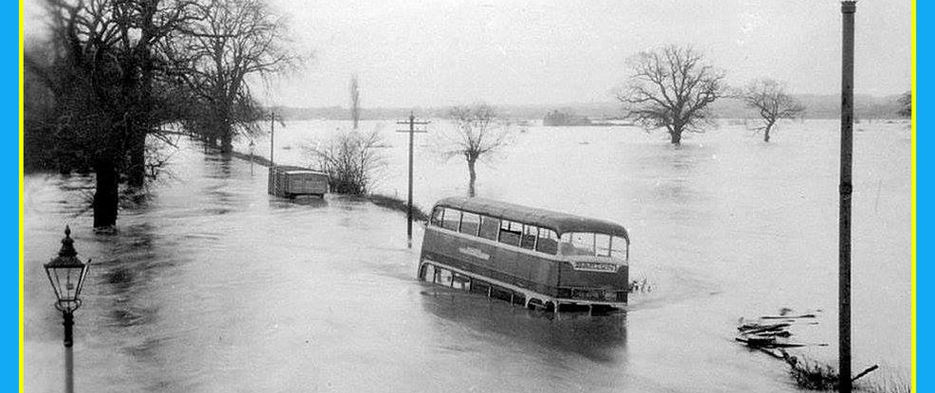
Crossroads

Wilford Crossroads sit at the junction of Ruddington Lane, Wilford Lane, Clifton Lane and Main Road. Wilford Green, often referred to as the 'Upper Green', was the site of the village smithy, pinfold and the village stocks. The Green was the sight of an Air Raid Shelter, serving residents in the surrounding area. The Upper Green formed the main entrance to the village and, as the residential area expanded, became a focal point for the community in addition to the Village Green (Lower Green). The most recently used ford crossing the River Trent ran between the Wilford Green Crossroads and Trentside Farm on Lenton Lane, roughly the current location of Clifton Bridge. This was referred to as the 'Upper Ford' in contrast to the 'Lower Ford' running between the Bee Bank and Tottle Brook.
At the North-West corner of the crossroads was formerly an alehouse serving ford users, under the sign of "The Star". The alehouse was built in 1781 and lasted just over a century. A call at a public house was necessary before undertaking the often dangerous crossing at the Upper Ford. This was later the site of the village post office and is now a private dwelling.
Points of Interest
The Village Pinfold and Smithy:
The Wilford Pinfold was located on Wilford Green by the Crossroads, along with the village smithy, at the current site of Pinfold Lane. The Pinfold (also known as a pound - both words rooted in the same Saxon word 'pund' meaning enclosure) was where stray farm animals were driven into and kept at the expense of the owner until a fine was payed to the person on whose land they had strayed (for damage done) and a fee to the pound keeper for feeding and watering the same. If the animal was not claimed within three weeks, the animals were driven to the nearest market and sold, the proceeds going to the impounder and pound-keeper. An ingenious form of receipt was sometimes used. The person who found the animals on his land cut a stick and made notches, one for every beast, and then split the stick down the centre of the notches so that half each notch appeared on each stick; one half he kept, the other he gave to the pound-keeper. When the owner came to redeem his property and had paid for the damage done, the impounder gave him his half stick. He took this to the pound-keeper, and if the two pieces tallied, it proved he had paid and his beast was freed. Hence the word tally-stick and the pound-keeper being referred to as the tallyman". On the south-east corner of the crossroads stood the Village Smithy. The building was in two parts - one in which horses were housed whilst waiting for their shoes to be fitted and the other in which the forge and bellows were used to make the shoes. Attached to the smithy was a small shed in which was stored a hand-pulled barrow on two wheels complete with hoses and buckets to be used as the local first-response fire engine.
Wilford Hall:
The imposing and elegant house on the south side of Clifton Lane, was designed by Loughborough architect Samuel White in 1781 for the family of Samuel Smith, Esq and remained the seat of the Smith family for almost a century. The redbrick country house, originally named Wilford Hall, was part of an extensive estate featuring stables, house staff lodges, and a private chapel. The house staff lodges, now private dwellings on the northwest corner of the crossroads, were built without upstairs windows in order to not overlook the Hall's grounds. The chapel was a known location for local dissenters - the same group of regional separatists who went on to found the Plymouth Colony in 1620. The House was later owned by the Forman Hardy family, founders of the Nottingham Evening Post in 1878. By WW2, the house was home to between fifteen to twenty apprentices from the Royal Ordnance Factory in King’s Meadow. The grounds were converted for use as a sports arena and a modern two-storey block was added when it was converted into office use in the 1980s. Wilford Place, a residential estate, was built on the grounds in 2006.
The Stables:
As part of the Wilford House estate stood an impressive Stable Block built in 1781, built across Clifton Lane from Wilford House. The Stable Block housed a large number of horses and carriages for the wealthy Smith family, and was later used to house the automobiles of the Forman-Hardy family before being sold off due to its separation form the rest of the Wilford House estate by Clifton Lane. The building subsequently found life as a garden centre, and more recently as a restaurant. It first opened in its most recent form as Wilford Farm Inn in the 1990s.
Wilford Round House and Fairham Brook:
The Round House was a picturesque little semi-circular folly castle, complete with battlements that stood on the East bank of the Trent - alongside Fairham Brook. It was surrounded by apple trees, gooseberry bushes and raspberry canes and served as a focal point for picnics and playing children in the meadows surrounding Fairham Brook. It was built as a gatehouse to the entrance of Clifton Grove, the majestic driveway lined with Elm Trees all the way up to Clifton Hall. The Round House was also used as a place of refreshment for the Clifton Family ahead of their long drive up to the Hall. By the 1920s, the Round House had been taken into private ownership (namely, the Ancliffe family) from whom visitors could buy a sustaining tea of bread and butter, eggs and fruit for one and sixpence to eat in the pleasant surroundings. The Round House was demolished in the 1960s to make way for the A52 and Clifton Bridge. It stood roughly 25 metres directly northeast of the Clifton Lane Ambulance Station. Fairham Brook has over many decades altered its route both through natural diversion and industrial intervention. Throughout much of the history of Wilford, the brook continued to run parallel to the River Trent up until Bell Lane where it would combine. This point was later the outflow site of the first major sewage works in Wilford. In decades since, the stream has been diverted to join the River at an earlier point - most recently with the building of Clifton Bridge. The source of the brook is on the edge of the Nottinghamshire Wolds, near Old Dalby, Leicestershire. The Fairham Brook Bridge stood, flanked by two dominant stone pillars, at the entrance to Clifton Grove. It is noted by Robert Mellers in his 1914 articles on historic Wilford, that in 1910 the bridge was crushed by heavy traction traffic and a new one, with moulded stone caps—an ornamental feature in the locality—was built, at a cost of £250, by the Basford Rural District Council.
The Smith Family:
The Smith Family was an aristocratic and illustrious Nottingham family that founded the Smith’s Bank of Nottingham, now part of NatWest, the first bank founded outside of London. They were intrinsically linked with the Wilford community through charity and courtesy. Abel Smith II and his fourth son, Samuel Smith, built Wilford Hall (later House) in 1781. The Smith family, later the Carringtons and Caringtons, had a long legacy as Members of Parliament. Five of Abel Smith II's sons went on to become Members of Parliament. The most recent descendent was Peter Carington, 6th Baron Carrington, Foreign Secretary under Margaret Thatcher and 6th Secretary General of NATO. Abel Smith II and his family were devout Christians with a private chapel on site. They employed local men to sell Bibles and religious tracts door to door and granted them free lodging provided in a house in Witham’s Yard, further along Wilford Lane, appropriately named ‘Pilgrim’s House’. Witham's Yard itself, a collection of farm cottages for the Witham family, is reputed to have been built on the site of a former monastery - a claim strengthened by the discovery of large stone blocks in the 1970s and a brick-built culvert in 1985. Henry Smith, Abel Smith II's third son, built the Dame School still standing at the corner of Leander Close and Main Road. He was also the primary funder of the first major sewage works in the village leading from the Village Green down Main Road and towards Fairham Brook, meeting the river at the end of Bell Lane where, at that time, Fairham Brook reached the river. In 1878, Abel's great-grandson, Henry Abel Smith, presented a Henry Willis built organ to St Wilfrid's Church. Wilford Cottage, later a public house most recently named The Chateau, was built further east along Wilford Lane for additional family members. Lady Lucy Smith, Samuel Smith's daughter-in-law, was a notable example of the philanthropic nature of the family. She would stand for hours outside Wilford House every day, attending to the poor people of the community; and even up to a week before she died, sent £5 to a local poor farmer who had suffered much from the cattle plague. She died in 1865, aged 71. Early generations of the Wilford-based family maintained a family vault at St Wilfrid's Church.
Smith Family Links to Slavery:
The Smith family, as was common at the time within aristocratic circles, had links to the transatlantic slave trade. Abel Smith was a partner in the London bank Smith Payne & Smith who were heavily involved in the credit arrangements of West India planters in part through their ties with the West India merchant firm Manning & Anderdon. Smith, Payne & Smith had taken possession of a Farm Estate in Jamaica in the 1790s and were mortgagees of enslaved people on the Holland, Fish River and Petersville plantations in Jamaica in the 1820s. Smith was awarded compensation for the ownership of 222 enslaved people on Raymond’s estate in Jamaica as trustee of the marriage settlement of Harriet Smith, daughter of William Wilberforce’s first cousin Robert Smith, 1st Baron Carrington.
William Wilberforce:
William Wilberforce (1759-1833) regularly stayed at Wilford House with his Uncle-in-law, Abel Smith II (1717–1788). Wilford sat comfortably roughly midway between his ancestral home and constituency in Kingston-Upon-Hull (later for Yorkshire) and his work in Westminster. He stayed with his Uncle in Wilford often for months at a time. It is known from his diaries that Wilberforce stayed for several months between the years of 1786 and 1789 during the height of his campaign for the abolition of slavery. Wilberforce grew close to the Smith family over time. The Smith family’s role in the slave economy posed no bar to Wilberforce’s affection. Abel Smith (1788–1859), son of Samuel Smith and grandson of Abel Smith II, had become one of Wilberforce's closest friends and colleagues and was chosen by Wilberforce to be the executor of his will when he died in 1833.
Gallery
Oral History

Welcome
#ThanksToYou
Without National Lottery Heritage funding, our Heritage Project would not have gone ahead – and without the players there would be no funding – so we would all like to say a massive THANK YOU to everyone who supports us in this way!

























